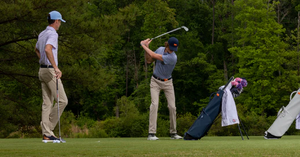How To Use a 60-Degree Wedge
A lot of golfers have some hesitations about using 60-degree wedges, and it's understandable. They often have much more power behind them than comparable wedges, making their swings feel more unpredictable and inconsistent.
However, once mastered, this wedge may become one of your favorites. In this guide, we'll take you through how to use a 60-degree wedge to the best of its ability in various settings. By the end, you should feel more confident than ever.
How To Hit a 60-Degree Wedge
Long Pitch Shots
A key characteristic of a 60-degree wedge is its high loft angle. This makes hitting full long-pitch shots with any consistency a pretty tall order, but not impossible. With a full swing, you can expect your 60-degree wedge to send your ball roughly 80 yards with a high flight and plenty of spin. The ball will stop relatively quickly once it hits the green, putting you in the perfect position for more accurate swings.
60-degree wedges aren't for everybody, but if you're comfortable making repeated full-swing shots and risking the lack of consistency, then you could benefit from the power and flight it provides. With that in mind, let's walk you through how to make that all-important long-pitch shot.
The first thing you need to do is ensure you have the proper grip and posture. Interlock your fingers and stand with your feet shoulder-width apart. Make sure the ball is just forward of center. If it's too far back, your swing will be too steep, and it'll likely result in a too-fat/thin shot.
Finally, when you swing, make sure you utilize plenty of upper body rotation. This will give the shot the power it needs to get it where you need it to go. Although it won't travel as far as an iron shot, with the right power, you can cover a lot of ground.
Short Pitch Shots
If you're not trying to send your ball soaring through the sky, a chip shot with a lower-lofted club is the way to go. This is primarily because they're easier to hit and often provide greater consistency. However, this only works if you have enough green to work with. Sometimes, getting your ball to travel short distances still requires significant height, which brings us to short-pitch shots.
As we've already stated, 60-degree wedges are perfect for generating height and significant spin. If you're in a tight spot and need to move the ball a small distance but also height to achieve that, a high-lofted lob (such as the 60-degree wedge) is ideal. Chip shots are helpful and easy but not always the right answer.
Let's learn how to hit a short-pitch shot with your 60-degree wedge. Similarly to the long-pitch shots, you'll need to start with a firm grip on your club. Unlike long-pitch shots, however, you should use roughly fifty-percent less grip pressure. This is because if you swing with too much force, your ball will fly across the course instead of achieving the short distance you're aiming for.
Next, stand with your feet shoulder-width apart and the ball just forward of center. The aim here is to get the club head under the ball, as this will provide the significant spin we're hoping for.
Your swing should be short. You can achieve this by keeping the amount of power you put into your swing in check. Make sure you aren't swinging with all your strength. The best way to do this is by locking your trail arm into your chest from elbow to shoulder. Then, swing! The ball should glide over obstacles and land a short distance ahead.
Bunker Shots
Finally, it's time to talk about bunker shots. This is where the 60-degree wedge excels. The height, spin, and power behind a 60-degree shot are more than enough to get you out of those tricky (and often frustrating) situations.
A good bunker shot requires that the ball rises high enough to escape the pit but not travel too far along the green. Even high-lipped bunkers are no match for the height a 60-degree wedge can provide.
To hit a bunker shot, you need to open the clubface and then regrip the club. You want as much height as possible here. Opening the face allows the wedge to point almost directly upward, precisely where you want it to go. A key difference with a sand bunker shot is that you aren't actually aiming for the ball itself, but rather the sand behind it.
Strike from a few inches behind, utilizing a wide stance, and try to ‘splash’ the ball out of the sand. Most of your weight should be on your front foot, and your swing should be fairly shallow. Remember, we aren't trying to send the ball hurtling away - we just need to free it from the bunker.
Frequently Asked Questions
Is a 60-Degree Wedge Hard To Hit?
Without practice, hitting a 60-degree wedge can be challenging for many players, especially if you aren't used to them. 56-degree wedges are easier to hit and can provide a similar distance. However, with some practice, you can make the most of the power behind a 60-degree wedge.
What Is the Best Way To Use a 60-Degree Wedge?
60-degree wedges are best used for getting out of tough spots when you're stuck. This is primarily due to the height and significant spin they can provide on your swing. They're great for getting balls out of pits or over obstacles, thanks to the spring they had to your shot. They're a must-have in a golfer's arsenal.
Final Thoughts
So there you have it, a full guide on how to use a 60-degree wedge in your game. Get out on the course and try it for yourself! You'll feel like a pro in no time, and don’t forget to check out our full range of gear and apparel before heading out.



